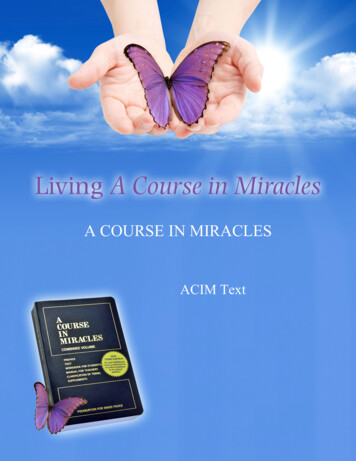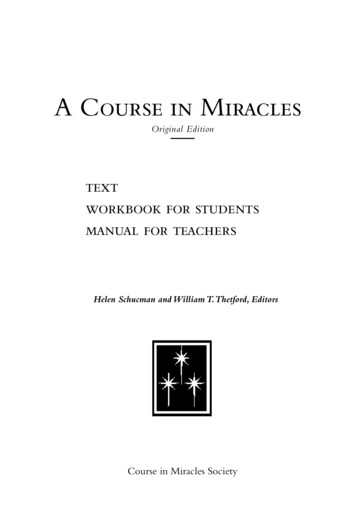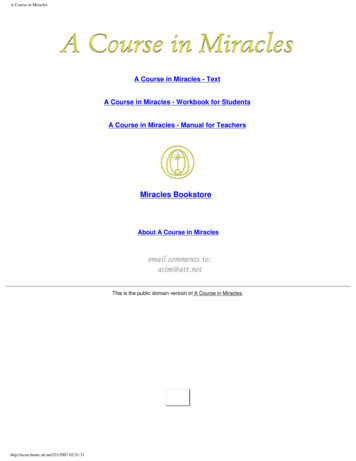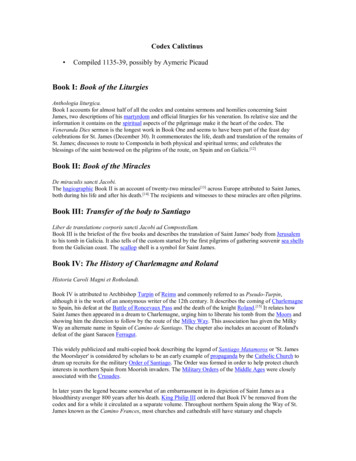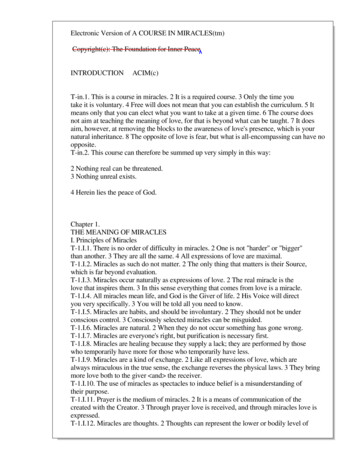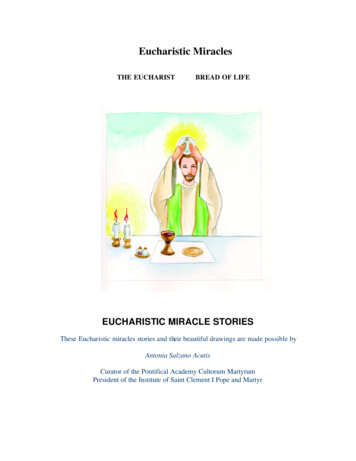
Transcription
Eucharistic MiraclesTHE EUCHARISTBREAD OF LIFEEUCHARISTIC MIRACLE STORIESThese Eucharistic miracles stories and their beautiful drawings are made possible byAntonia Salzano AcutisCurator of the Pontifical Academy Cultorum MartyrumPresident of the Institute of Saint Clement I Pope and Martyr
Eucharistic Miracle of LancianoITALY, 750In the year 750, at Lanciano in the Abruzzo region of Italy, above the place where the Church dedicated to St.Francis of Assisi stands today, a Eucharistic Miracle took place whose precious Relics are still preserved today,and which it is possible to visit. The various chronicles of the time recount how in the year 750, a priest wascelebrating Holy Mass. At the exact moment of the Consecration, he was tormented by strong doubts as towhether the Body and Blood of Jesus were truly present in the consecrated Host. He had just finished theConsecration when he noticed that the Host had been transformed into Flesh and the Wine into Blood. Thepriest, filled with regret for having doubted, began to weep and beg pardon from God. In the chronicles, thetestimony of numerous members of the faithful who witnessed the Miracle, are also recorded. In 1970, analysisof the Relics confirmed that the Host transformed into Flesh is true Flesh, consisting of striated muscle tissue ofthe myocardium (part of the heart) and that the Wine transformed into Blood is true Blood of the blood typeAB, which is the same as that found on the Shroud of Tur in.
Eucharistic Miracle of RomeITALY, 6th – 7th CenturyWhile Pope St. Gregory was celebrating Holy Mass in the ancient church dedicated to St. Peter, at the momentof distributing Holy Communion, he noticed that among the faithful standing in line was also present one of thewomen who had prepared the bread for consecration (it was the custom in those days that the bread used for theMass was prepared by the faithful themselves). The woman, however, was laughing out loud, and the Popeasked her the reason for her behavior. The woman defended herself by saying she could not bring herself tobelieve how it was possible that the very bread which she herself had prepared with her own hands, thanks tothe words of the consecration, became the Body and Blood of Christ. St. Gregory then prohibited her fromgoing to Communion and began to pray to God to enlighten her. He had just finished praying when he saw thatvery piece of bread prepared by this woman turn into flesh and blood, at which point the woman repented, fellto her knees, and began to weep. Part of the Reliquary is still preserved to this day at the BenedictineMonastery in Andechs, Germany.
Eucharistic Miracle of TraniITALY, 11th CenturyAt Trani in the Puglis region of Italy, the Relic of a Eucharistic Miracle which took place around the year 1000is preserved in the Church of St. Andrew. A woman of a non-Christian religion, not believing in the RealPresence of Jesus in the Eucharist, was pretending to be a Christian, and during the celebration of Massmanaged to steal a consecrated Host, which after she arrived home, she put into a pan full of grease and fried itover the fire. Upon contact with the boiling oil, the Host miraculously became flesh and so much blood beganto pour out that it spilled onto the floor. The woman, terrified, began to shout so loud that she drew theattention of the whole neighborhood, as well as the civil and church authorities.
Eucharistic Miracle of St. Peter DamianITALY, 11th CenturyIt is St. Peter Damian himself, a Doctor of the Church, who describes this miracle, of which he was a directwitness. In the year 1050, a young woman, urged on by a sorceress, managed to steal a consecrated Host inorder to commit a sacrilege. The woman hid the Host in a handkerchief and headed immediately toward theexit of the church, but the priest caught up with her right away and demanded that she give the Host back tohim. The woman then opened the handkerchief and noticed that the Host was transformed in such a way thathalf had become bleeding Flesh, while the other half remained the same.
Eucharistic Miracle of AlatriITALY, 1228At Alatri, the Relic of a Eucharistic Miracle which occurred in the year 1228, consisting of a fragment of a Hosttransformed into flesh, is still preserved today at the Cathedral of St. Paul the Apostle. A young woman, to winback the love of her fiancé, had recourse to a sorceress, who ordered her to steal a consecrated Host to make alove potion out of it. During a Mass, at the time of Holy Communion, the young woman managed to steal aHost, which she hid in a piece of cloth. When she arrived home, she noticed that the Host had been transformedinto bleeding flesh. The woman then ran immediately to the sorceress, and together they went to the Bishop toask for pardon. Numerous documents speak of this Miracle, including a Papal Bull Fraternitas Tuae of March13, 1228, written by Pope Gregory IX in response to the Bishop of Alatri, who asked him how he should act inregard to the two sacrilegious women. The Supreme Pontiff Gregory IX, pardoned the two penitent women,interpreting the incident as a sign sent by the Lord in response to the various heresies concerning the RealPresence of Jesus in the Eucharist which were circulating at that time.
Eucharistic Miracles of FlorenceITALY, 1230-1595Florence 1230Florence 1595The Relics of two Eucharistic Miracles, which took place in 1230 and in 1595 respectively, are preserved in theChurch of St. Ambrose in Florence.In the Miracle of 1230, a priest named Fr. Uguccione, having finished Holy Mass, by mistake left behind somedrops of the consecrated Wine in the chalice. The following day, returning to the same church to celebrateMass, he found in the chalice some drops of coagulated, living blood of a flesh color. The blood wasimmediately poured into a cruet made of crystal. In 1980, the 750th anniversary of the miracle wascommemorated.The Second Eucharistic Miracle took place on Good Friday of the year 1595. By mistake, a candle was left stilllit on the altar of the side chapel, called the Chapel of the Holy Sepulchre, which caused a raging fire. Thepeople ran immediately to put out the fire and succeeded in salvaging the Blessed Sacrament and the chalice. Inthe general confusion, six consecrated Hosts fell from the ciborium onto the flaming carpet, and despite the fire,they were recovered intact and still next to each other. In 1628, the Archbishop of Florence, Marzio Medici,after having examined them, found them to be incorrupt and therefore had them placed in a precious Reliquary.
Eucharistic Miracle of VolterraITALY 1472In 1472, during the war which broke out between Volterra and Florence, a Florentine soldier, having entered theCathedral of Volterra, succeeded in taking possession of the precious ciborium, made of ivory, which containedseveral consecrated Hosts. As he was leaving the church, seized by a fit of anger toward Jesus in the Eucharist,he threw the ciborium with its precious contents against a wall of the church. All the Hosts fell out of theciborium, but illuminated by a mysterious light, they rose up in thin air and remained suspended there for sometime. The soldier then fell to the ground in fear, and having repented, began to weep. There were numerouswitnesses who were present at this miracle.
Eucharistic Miracle of DroneroITALY 1631On Sunday, August 3rd in 1631, around the time for Vespers, a great fire broke out in the little town ofDronero, in the region under the reign of the Marquis of Saluzzo. A young peasant woman carelessly set fire tosome dry straw at the very moment when the wind was growing stronger because of an impending storm. In afew seconds, the flames spread violently, engulfing the dwellings on the Borgo Maira. The people attempted inevery way to put out the fire, but every attempt turned out futile. The fire, meanwhile, kept spreading more andmore. Father Maurizio of Cava, a Capuchin priest, was inspired to have recourse to the power of Jesus hiddenunder the veil of the Eucharistic species. He at once organized a solemn procession with the BlessedSacrament, and followed by all the citizens, moved toward the place of the fire. At the approach of the BlessedSacrament, the fire miraculously stopped.
Eucharistic Miracle of Cava dei TirreniITALY, 1656At Naples, in May of 1656, a terrible epidemic of the plague broke out because of the invasion by Spanishsoldiers from Sardinia. The epidemic spread quite rapidly in the villages and in the surrounding countryside,arriving also in the small town of Cava dei Tirreni. There were thousands of victims, both in the city and in thecountryside. Father Paolo Franco, one of the few spared by the plague, inspired from on high, and defyingevery danger, called the people together and directed that a procession of reparation be made to Mount Castello,situated at a distance of a few kilometers. When they arrived at the top of the mountain, Fr. Franco blessedCava dei Tirreni with the Blessed Sacrament. The plague miraculously ended and even today, each year in themonth of June, the people of Cava march in solemn procession in commemoration of the miracle.
Eucharistic Miracle of PatiernoITALY, 1772In 1772, unknown robbers stole a certain number of consecrated Hosts from the Church of St. Peter in Patiernowhich were recovered in the territory of the Duke of Grottolelle a month later, under a pile of manure,completely intact. It was possible to find them thanks to the appearance of mysterious rays of light and a doveover the place where they were buried. Saint Alphonsus Maria di Liguori described this Miracle in detail.Moreover, the circumference of the Particles stolen from the Church of St. Peter at Patierno perfectly matchedthe iron mold used to fashion them, along with the incision marking them as property of that same Church of St.Peter.
Eucharistic Miracle of Saint Mauro la BrucaITALY, 1969On the night of July 25, 1969, some thieves secretly came inside the parish church of St. Mauro la Brucaintending to steal its most precious objects.After forcing open the tabernacle, they also stole from it the ciborium containing several consecrated Hosts.Just after they left the church, the robbers threw the Hosts onto a small path. The following morning, a smallchild noticed a small pile of Hosts at the corner of the path, and after gathering them up, immediately deliveredthem back to the pastor. Only in 1994, after 25 years of thorough analysis, did Most Reverend Biagiod’Agostino, Bishop of Vallo della Lucania, officially recognize the miraculous preservation of the Hosts andapproved their veneration. From the analysis carried out by scientists and chemists, we now know thatnormally, unleavened flour is heavily damaged already after six months, and at a maximum of a few years, isreduced to pulp and then to dust.
Eucharistic Miracles of MeerssenHOLLAND, 1222-1465Meerssen 1222Meerssen 1465In the small town of Meerssen, in 1222 and in 1465, two important Eucharistic Miracles were confirmed. In thefirst Miracle, during Holy Mass, from the big consecrated Host, living Blood poured out which stained thecorporal. In the second Miracle, in 1465, a peasant succeeded in saving the Relic of the Miracle from a firewhich destroyed the entire church. This episode was remembered by the inhabitants with the name of “theMiracle of the fire.” Despite the fire, the church was immediately rebuilt, and in 1938, Pope Pius XI elevatedit to the status of a Minor Basilica.
Eucharistic Miracle of Boxtel- HoogstratenHOLLAND, 1380In 1380, the priest Fr. Eligio van der Aker was celebrating Holy Mass at the Church of St. Peter. Shortly afterconsecrating the species of wine, he accidentally spilled it on the corporal and on the altar cloth. Even thoughhe had used white wine for the Mass, it was transformed into Blood. At the end of the celebration, the priest raninto the sacristy and tried to remove the Blood stains from the sacred linens, but every attempt of his wasuseless. Not knowing what to do, he hid the altar cloth and the corporal in a case under his bed. It was onlywhen he was about to die that he revealed the secret to his confessor, Father Henry van Meerheim, whoimmediately informed Cardinal Pileus, who at that time was the apostolic nuncio of Pope Urban VI and titularArchbishop of the Church of Saint Praxedes. The Cardinal, after conducting a thorough investigation of howthese eve nts unfolded, approved the veneration of the relics by decree on June 25, 1380.
Eucharistic Miracle of AlkmaarHOLLAND, 1429In the Cathedral of St. Lawrence at Alkmaar, there is preserved the precious Reliquary in the form of an Angelwhich contains the chasuble stained with blood from the Eucharistic Miracle which occurred in 1429. On May1, 1429, a priest named Fr. Folkert celebrated his first Mass in the Cathedral of St. Lawrence. The pastor, Fr.Volpert Schult, also attended the celebration. Shortly after pronouncing the words of consecration, Fr. Folkertaccidentally spilled the white wine contained in the chalice on his chasuble, and in its place there appearedliving Blood. After Mass was over, giving in to panic, he cut off the hem of the chasuble stained with bloodand burned it, and then took the torn part and began to sew it back together. After he finished mending it, thechasuble again was found to be stained with blood. The two priests, not knowing what to do, quickly went tothe Bishop of Utrech with the chasuble. Only in 1433 did the Bishop, after numerous canonical investigations,officially approve the veneration of the Miracle.
Eucharistic Miracle of CimballaSPAIN, 1370The “Most Holy Doubtful Mystery” is the name by which the Eucharistic Miracle which occurred at Cimballain 1370 at the church of the Purification of the Blessed Virgin Mary is known. Father Tomás, the pastor of thechurch, had been tormented for many months by doubts regarding the Real Presence of Jesus in the Sacramentof the Eucharist. One Sunday, during the celebration of Holy Mass, after pronouncing the words ofconsecration, Father Tomás saw the Host be transformed into Flesh and the Blood flow so abundantly from itthat it spilled on to the corporal. The repentant priest began to weep from remorse and the faithful, seeing himso upset, ran at once up to the altar and saw the Miracle. The Relic was carried as it was in procession and thenews of the Miracle spread everywhere. Many Miracles were attributed to the “Most Holy Doubtful Mystery”which from that time has always been an object of great devotion on the part of the faithful. The Relic of thecorporal stained with Blood is exposed every year on September 12 on the occasion of the anniversary of thefeast of the Miracle.
Eucharistic Miracle of MontserratSPAIN, 1657In 1657, the Most Reverend Father Bernardo de Ontevieros, General of the Benedictine Order in Spain, togetherwith the Abbot Fr. Millán de Mirando, were in the monastery of Our Lady of Montserrat to participate in someconferences. During one of these, a woman with her little daughter came to the monastery and began to implorethe Abbot Fr. Millán to celebrate three Masses in memory of her deceased father, deeply convinced that withthese three Masses, the soul of her father would be freed from the pains of Purgatory. The good Abbot, movedby the tears of the little girl, began on the following day to celebrate the first Mass for the repose of his soul,when the little girl, who was present there with her mother, during the consecration began to remark that shesaw her father bowing his head at the foot of the main altar, surrounded by dreadful flames. The FatherGeneral, skeptical, to test whether the little girl’s story was true, told her to place a handkerchief into the flameswhich surrounded her father. The young girl, in accord with his request, placed a handkerchief in thatmysterious fire, which only she was able to see, and immediately all the monks saw the handkerchief burn witha most brilliant flame. During the second Mass, the little girl declared that she saw her father standing up nextto the deacon, dressed in an outfit of many vivid colors. At the third and final Mass, the father showed himselfto his daughter, this time with an outfit as pure white as the snow. Just as the Mass ended, the little girlexclaimed: “Look at my father – he is leaving and going up to heaven!” The little girl then thanked thecommunity of monks on behalf of her father, who had requested her to do so. The Most Reverend FatherGeneral of the Benedictine Order in Spain, the Bishop of Astorga, and many inhabitants of the region werepresent at this Miracle.
Blessed Alexandrina Maria da CostaPORTUGAL, 1904-1955Alexandrina Maria was born in Balasar (Portugal) on March 30, 1904. At age 14, while trying to flee andpreserve her own chastity which was threatened by three men, she was unsuccessful in jumping from thewindow. The consequences were disastrous, although not immediate, and in fact, after several years, she wasconstrained to lie in bed for the remaining 30 years of her life because of a debilitating paralysis. She did notdespair, but decided to put her trust in Jesus with these words: “As You are a prisoner in the tabernacle and Iam a prisoner in my bed by your Will, we can keep each other company.” Afterwards, she began to have evermore intense mystical experiences, so that from Friday, October 3, 1938 to March 24, 1942, for at least 182times, she experienced every Friday the sufferings of the Passion. Beginning in 1942 up to the time of herdeath, Alexandrina was fed only with the Holy Eucharist, and during her stay at the Foce del Douro Hospital inOporto, she was examined by several doctors during her total fast and anuria (absence of urine). After ten longyears of paralysis which she offered in Eucharistic reparation and for the conversion of sinners, on July 30,1935, Jesus appeared to her and said: “I have placed you in the world to make yo u live only by Me, to givetestimony to the world of how precious is the Eucharist [.] The strongest chain that binds souls to Satan is theflesh, the sins of impurity. Never has there been seen such a spread of vices, evil deeds, and crimes as there istoday! Never had there been so much sin [.] The Eucharist, My Body and Blood – the Eucharist: this is thesalvation of the world.” Mary also appeared to Alexandrina on September 2, 1949, with rosary beads in herhand, telling her: “The world is in agony and is dying in sin. I desire prayer, I desire penance. Protect with thismy Holy Rosary all those whom you love and the whole world.” On October 13, 1955, the anniversary of thelast apparition of the Virgin Mary at Fatima, Alexandrina was heard exclaiming: “I am happy, for I am going toheaven.” At 7:30 in the evening that same day, she died.For over thirteen years she nourishes herself with just the Eucharist
Saint Catherine LabouréFRANCE, 1830Catherine Labouré was born on May 2, 1806 to afamily of farmers. On April 21, 1830, she entered thereligious order of the Daughters of Charity at themother house on the Rue de Bac in Paris. HereCatherine, in 1830, received the famous apparition ofthe Immaculate Virgin Mary, who told her: “Have amedal minted according to what you see before you:whoever wears it around their neck will receive greatgraces.” During her entire period of residence on theRue de Bac, Catherine also received the grace ofseeing Jesus in the consecrated Host, at the moment ofHoly Communion as well as during exposition of theBlessed Sacrament.Catherine herself describes the moment of theapparition in this way: “While I was makingEucharistic Adoration in deep silence, I seemed tohear from the side of the apse a sound like the rustlingof a silk dress. I looked up and saw the BlessedVirgin. She was of medium height and indescribablebeauty. A white veil was draped over her head andflowed down almost to her feet, which were standingon a half- globe. Her hands, raised to the level of herwaist, supported in a very natural way another globewhich was smaller and golden, surmounted by a crossof pure gold. She had her eyes turned toward Heaven.While I was intent on contemplating it, she loweredher eyes toward me and said these words to me: “This globe which you see represents the entire world, Francein particular, and every individual person.” And the Virgin added: “The rays are a symbol of the graces whichI shower upon those who ask them from me,” in this way making me realize how sweet it is to pray to theBlessed Virgin and how generous She is to those who invoke her. And then, I saw an oval-shaped backgroundform around the Blessed Virgin, on which in an upward direction, forming a semicircle from Mary’s right handto her left, could be read these words, written in golden letters: “O MARY, CONCEIVED WITHOUT SIN,PRAY FOR US WHO HAVE RECOURSE TO THEE.” At this point, the globe which the Blessed Virgin hadoffered to God disappeared. Her hands, laden with graces, were bent toward the globe on which She rested herfeet, subduing the head of a greenish serpent with yellow spots. Suddenly the scene was turned around and Iwas presented with the “back of the medal,” which displayed the monogram of Mary surmounted by the Cross;in the background were two Hearts: that of Jesus crowned with thorns and that of Mary pierced by a sword.All around, serving as a frame, there was a royal crown of twelve stars. At that point I he ard a voice which saidto me: “Have a medal minted on this pattern. All those who have such a medal blessed and wear it, especiallyaround the neck, and recite the short invocation (“O Mary, conceived without sin.”), will rejoice in the specialprotection of the Mother of God and receive great graces. These graces will be in abundance for those whowear it faithfully.”
Eucharistic Miracles of LourdesFRANCE, 1888On August 22, 1888, at 4:00 in the afternoon, for the first time, a procession with a final benediction for the sickwith the Blessed Sacrament took place. It was a priest who proposed this devotional practice, and from thattime, it has never been abandoned. When on that August 22 of 1888, the sick were blessed in front of the grottoof the Apparitions with the Blessed Sacrament, Pierre Delanoy, who had been suffering for many years fromataraxia (an illness which impedes the coordination of voluntary motion, and leads to certain death), wasinstantly cured just as the Monstrance passed him. It was the first miracle ever to take place at Lourdes. Fromthat date onward, the Eucharistic procession for the sick has never been interrupted. Ever since that time, thesick who make their way to Lourdes on pilgrimage are blessed wit h the Blessed Sacrament, and the miraculoushealings which have been confirmed as the Blessed Sacrament passed by have been countless. The Shrine ofLourdes is a shining example of faith in the Real Presence of Jesus in the Eucharist.
The Angel of Peace, FatimaPORTUGAL, 1916
The Angel appeared three times to the shepherd children at Fatima to prepare them for future apparitions of theBlessed Virgin and to raise them to the supernatural state with Holy Communion. During the third apparition,the Angel gave Holy Communion to Lucia with a Host from which some drops of Blood fell and were collectedin a chalice. Francisco and Jacinta, who had not yet made their First Communion, were instead givenCommunion with the contents of the chalice. In this apparition, the Angel said to them: “Take and drink theBody and Blood of Jesus Christ, and which has endured such outrage from ungrateful men. Make reparation fortheir offenses and in this way you will console your God.”First Apparition of the Angel“We began to see, at a certain distance, a light that was whiter than snow, with the shining countenance of ayoung man, more resplendent than a crystal penetrated by the. as he drew near, we began to discern hisfeatures: a young man of 14 or 15 years, with great beauty. We were surprised and almost in rapture. We didnot say a word. As he approached us, he said “Do not be afraid. I am the Angel of Peace. Pray with me.” Andkneeling on the ground, he bowed his forehead to the earth. Moved by a supernatural power, we did the sameand repeated the words we heard him pronounce: “My God! I believe, I adore, I trust and I love Thee. I begpardon for those who do not believe, do not adore, do not trust, and do not love Thee.” “Pray in this way. TheHearts of Jesus and Mary will listen to the voice of your pleading.” And the Angel disappeared. Thesupernatural atmosphere which surrounded us was so intense that we hardly took notice of our own veryexistence for a long period of time.”Second Apparition of the Angel“The Angel said to us: “What are you doing? Pray! Pray more! The Sacred Heart of Jesus and theImmaculate Heart of Mary have merciful designs regarding you. Offer prayers and sacrifices constantly to theMost High.” “How should we make these sacrifices,” I asked. “In every way possible, offer to God in sacrificean act of reparation for sins by which He is offended and an act of supplication for the conversion of sinners. Inthis way, you will draw peace down upon your country. I am your Guardian Angel, the Angel of Portugal.Above all, accept and endure with humility the suffering which the Lord sends you.” And the Angeldisappeared.These words of the Angel were engraved on our spirit, like a light which made us comprehendwho God was: how He loved us and wished to be loved; the value of sacrifice, and how it was pleasing to Him;and how, through sacrifice, He would bring about the conversion of sinners.”The Third Apparition of the Angel“We saw the Angel with a chalice in his left hand and a Host suspended above it, from which some drops ofBlood fell into the chalice. Leaving the chalice and the Host in mid-air, the Angel prostrated himself on theground next to us and repeated three times the prayer: “Most Holy Trinity, Father, Son, and Holy Spirit, I adoreThee profoundly. I offer Thee the precious Body, Blood, Soul, and Divinity of Jesus Christ, present in all thetabernacles of the world, in reparation for the outrages, sacrileges, and indifferences by which He is offended.Through the infinite merits of the Sacred Heart of Jesus and the Immaculate Heart of Mary, I beg the conversionof poor sinners.” Then, getting up, the Angel again took the chalice and the Host into His hands, and then gavethe Host to me, and then gave the contents of the chalice to Jacinta and Francisco to drink, saying at the sametime: “Take and drink the Body and Blood of Jesus Christ, which has endured such outrage from ungratefulmen. Make reparation for their offenses and so console your God”.and the Angel disappeared.”
The following morning, a small child noticed a small pile of Hosts at the corner of the path, and after gathering them up, immediately delivered them back to the pastor. Only in 1994, after 25 years of thorough analysis, did Most Reverend Biagio . In the second Miracle, in 1465, a peasant succeeded in saving the Relic of the Miracle from a fire


